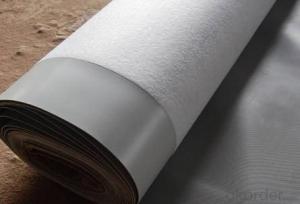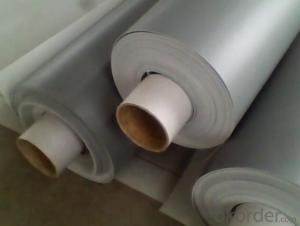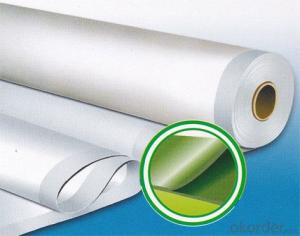PVC Waterproofing Sheet with Fleeced Back in Grey Color
- Loading Port:
- Shanghai
- Payment Terms:
- TT OR LC
- Min Order Qty:
- 20000 m²
- Supply Capability:
- 5000000 m²/month
OKorder Service Pledge
OKorder Financial Service
You Might Also Like
PVC Waterproofing Sheet with Fleeced Back in Grey Color
Product Description of PVC Waterproofing Sheet with Fleeced Back in Grey Color:
PVC Membrane Waterproof /Waterproofing membrane For Roof is a new polymer waterproof membrane. The PVC Membrane Waterproof /Waterproofing membrane For Roof raw material is polyvinyl chloride resin, mixed with plasticizer, filler, antioxygen, ultraviolet absorber and other auxiliaries.
Thickness: 1.2mm/1.5mm/1.8mm/2.0mm
Width:2050mm
Length:20m( Special specifications can be customized)
Size: 2.05mx20m
Color: white/grey, or any other colors.
Features of PVC Waterproofing Sheet with Fleeced Back in Grey Color:
1. Excellent anti-aging property.
2. Puncture- resistant.
3. Welding construction,
4. High tensile strength, good elongation, good dimensional stability.
5. Good plasticity.
6. It has self-extinguishing from fire property.
7. Materials surface is smooth, fast color, stain resistance.
8. More wide, Wastage become less when being used.
Classification of PVC Waterproofing Sheet with Fleeced Back in Grey Color:
1. N: Homogeneous PVC membrane
2. L: PVC membrane with fabric backing
3. W: Reinforced PVC membrane
Advantage of PVC Waterproofing Sheet with Fleeced Back in Grey Color:
1.) Mixing automation. Apply automatic temperature control automatic time control and automatic feed control.
2.) Extrusion equipment uses twin screw coextrusion. Screw temperature uses computer automatic temperature control system.
3.) Handpiece uses large width didhead extrusion equipment.
4.) Sophisticated three-roller calender equipment. The space between equiment is controlled by automation system.
Technical Data of PVC Waterproofing Sheet with Fleeced Back in Grey Color:
No. | Item | Model Ⅱ | |
1 | Tensile Strength Mpa ≥ | 12.0 | |
2 | Elongation at break% ≥ | 250 | |
3 | Shrinkage rate % ≤ | 2.0 | |
4 | Flexibility at low temperature | No crackle at -25oC | |
5 | Water tightness | Watertight | |
6 | Puncture resistance | Watertight | |
7 | Heat aging treatment | Appearance | Free from bubble, crack, cohesion and void |
Change rate of tensile strength % | +20oC | ||
Change rate of elongation at break | |||
Flexibility at low temperature | No crack at -20oC | ||
8 | Chemical corrosion resistance | Change rate of tensile strength % | +20 |
Change rate of elongation at break | |||
Flexibility at low temperature | No crack at -20oC | ||
9 | Artificial weathering | Change rate of tensile strength % | +20 |
Change rate of elongation at break | |||
Flexibility at low temperature | No crack at -20oC | ||
Application of PVC Waterproofing Sheet with Fleeced Back in Grey Color:
1) All kinds of roofs, such as steel structure roof, planted roof etc.
2) Underground engineering, such as building basement, subways, tunnels, air raid shelter, etc.
3) Other projects like artificial lake, dam, water reservoir, grain storehouse, etc.
Images of PVC Waterproofing Sheet with Fleeced Back in Grey Color:
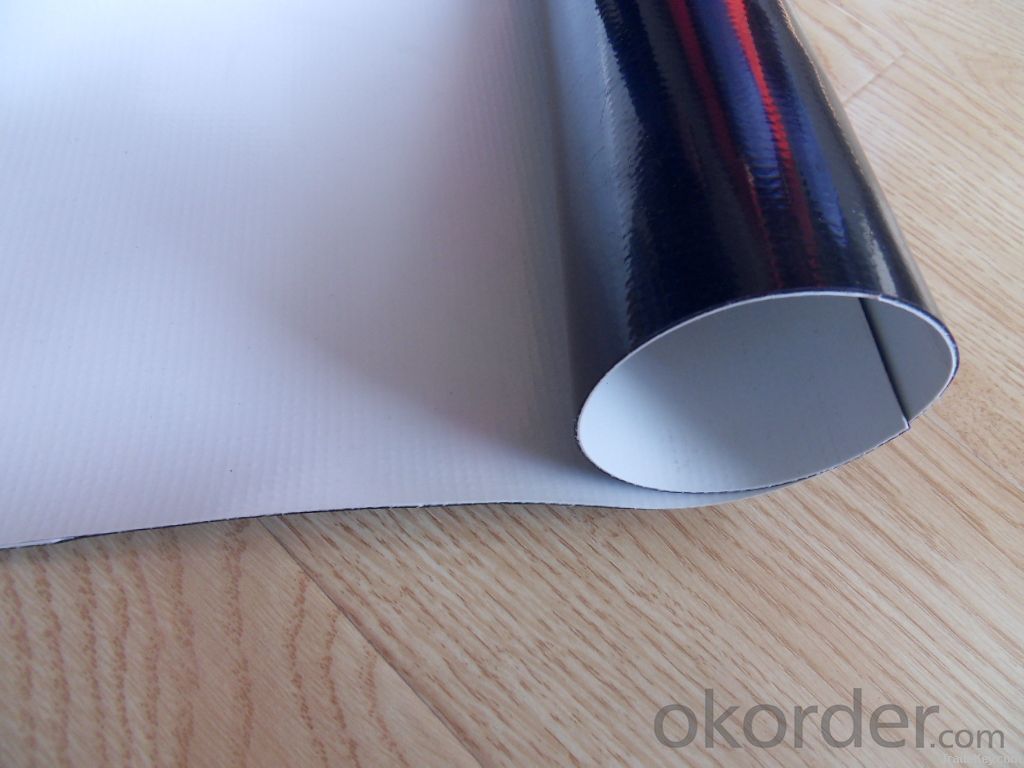
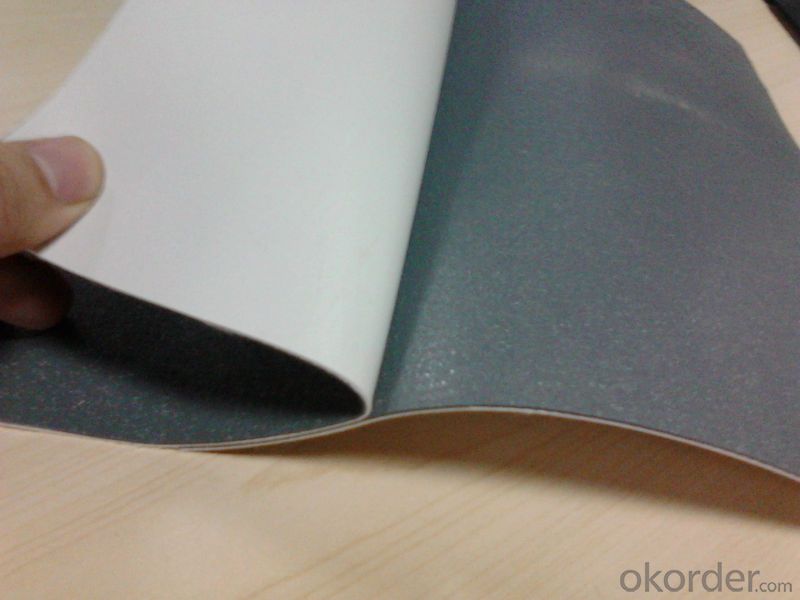
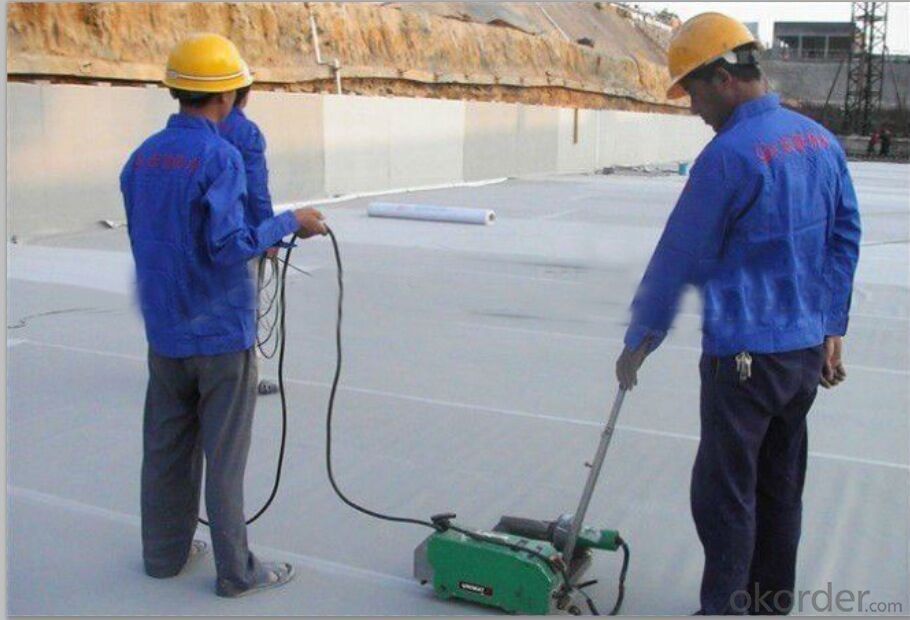

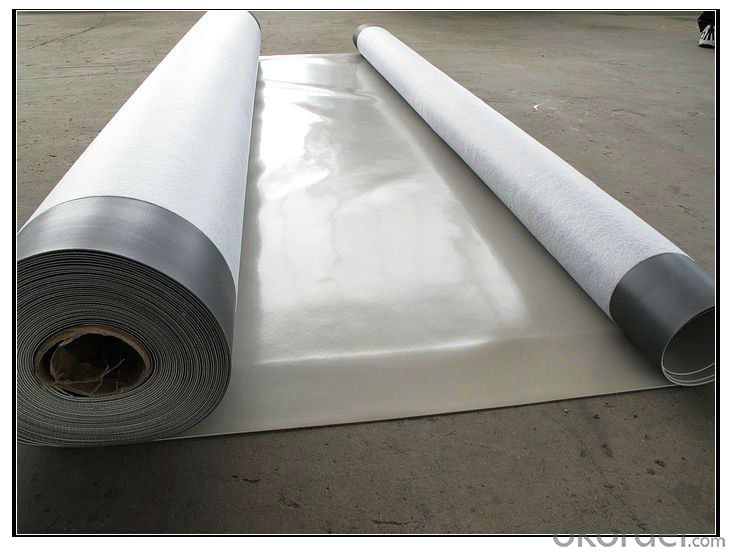
FAQ:
1. Can you produce 4m width?
Yes, no problem for us. We have four bases in China, largest one in this field.
2. How many quantity in one 20'' container for 1.2mm and 1.5mm?
480rolls, 11520m2 for 1.2mm and 400rolls, 9600m2 for 1.5mm
3. Can you provide free samples?
Yes, our samples are free, but express fees usually on buyer's account.
- Q:Can a waterproofing membrane be used for stadiums and sports arenas?
- A waterproofing membrane is suitable for stadiums and sports arenas, as they are subjected to different weather conditions and are susceptible to water damage. These large structures can be effectively protected against water infiltration by applying waterproofing membranes to various areas such as the roof, walls, and foundation. This not only maintains the building's integrity and extends its lifespan but also prevents expensive repairs caused by water damage. Moreover, these membranes offer insulation and energy-saving advantages, thereby improving the overall performance of the stadium or sports arena.
- Q:Can a waterproofing membrane be used on tunnels with architectural features?
- Indeed, tunnels with architectural features can benefit from the application of a waterproofing membrane. Such membranes possess versatility, enabling their usage on different structures, including tunnels with architectural elements. Their primary purpose is to establish a protective barrier against water infiltration, consequently safeguarding the structure against moisture-related harm. Regardless of the tunnel's unique architectural components, such as curves, arches, or decorative embellishments, a tailored waterproofing membrane can be tailored and implemented to ensure optimal water resistance. Therefore, it is imperative to seek guidance from a proficient waterproofing specialist experienced in working with tunnels and architectural features. They will assist in determining the most suitable membrane system for the specific project prerequisites.
- Q:Can waterproofing membranes be used on outdoor patios?
- Yes, waterproofing membranes can be used on outdoor patios. They are an effective way to protect the patio from water damage and can help to prevent leaks and moisture penetration. Waterproofing membranes create a barrier between the patio surface and water, keeping it dry and extending its lifespan.
- Q:Does a waterproofing membrane provide any insulation benefits?
- No, a waterproofing membrane does not provide any insulation benefits. The primary purpose of a waterproofing membrane is to protect the underlying structure from water damage by preventing water from penetrating through the surface. It acts as a barrier to keep water out and maintain the integrity of the structure. Insulation, on the other hand, is designed to regulate temperature and prevent heat transfer. It helps to maintain a comfortable indoor environment by reducing the transfer of heat between the interior and exterior of a building. Insulation materials are typically installed within the walls, floors, or roofs to provide thermal resistance and improve energy efficiency. While both waterproofing and insulation contribute to the overall performance and durability of a building, they serve different purposes. Waterproofing focuses on keeping water out, while insulation focuses on regulating temperature. Therefore, it is important to use both waterproofing and insulation materials in appropriate areas to ensure the best results.
- Q:Can a waterproofing membrane be used on concrete?
- Yes, a waterproofing membrane can be used on concrete. In fact, it is a commonly used method to prevent water penetration and protect concrete structures from moisture damage. A waterproofing membrane is a thin layer of material that is applied on the surface of the concrete to create a barrier against water and moisture. It can be made from various materials such as bitumen, rubberized asphalt, polyurethane, or acrylic. The membrane is typically applied in liquid or sheet form and adheres to the concrete surface to form a continuous and impermeable coating. This coating prevents water from seeping into the concrete, which can cause degradation, cracks, and other forms of damage. Waterproofing membranes are widely used in various concrete applications, including basements, foundations, roofs, and other structures that are exposed to moisture or water.
- Q:Can a waterproofing membrane be used for a shower pan?
- Yes, a waterproofing membrane can be used for a shower pan. In fact, it is highly recommended for ensuring the durability and long-term functionality of the shower pan. A waterproofing membrane acts as a protective layer that prevents water from seeping through the shower pan and causing damage to the underlying structure. By applying the membrane on the shower pan, it creates a barrier against water penetration, preventing leaks and potential moisture-related issues such as mold and rot. It is important to choose a high-quality waterproofing membrane specifically designed for shower pans to ensure its effectiveness. Additionally, proper installation and following manufacturer's guidelines are crucial to ensure a successful waterproofing solution for the shower pan.
- Q:Can waterproofing membranes be used on underground tunnels?
- Yes, waterproofing membranes can be used on underground tunnels. Waterproofing membranes are specially designed to provide a barrier against water penetration and are commonly used in various construction applications, including underground structures such as tunnels. These membranes are typically made of materials like bitumen, asphalt, or synthetic rubber, which have excellent waterproofing properties. When applied to the tunnel walls and floors, waterproofing membranes create a protective layer that prevents water from seeping into the tunnel. This is particularly important in underground tunnels as they are susceptible to water intrusion from surrounding soil or groundwater. By using waterproofing membranes, the integrity and durability of the tunnel structure are maintained, reducing the risk of water damage, corrosion, and deterioration. Furthermore, waterproofing membranes can also offer additional benefits such as providing resistance against chemical attacks, preventing the growth of mold and mildew, and improving the overall insulation of the tunnel. These membranes can be applied during the construction phase of the tunnel or as a retrofit solution to existing tunnels. It is important to note that the selection of the appropriate waterproofing membrane should be based on factors such as the type of tunnel, the expected water pressure, and the overall design requirements. Consulting with a professional engineer or waterproofing specialist is highly recommended to ensure the selection and installation of the most suitable waterproofing membrane for underground tunnels.
- Q:Can a waterproofing membrane improve energy efficiency?
- Yes, a waterproofing membrane can improve energy efficiency. A waterproofing membrane acts as a barrier against moisture intrusion, preventing water from seeping into the building envelope. By keeping the structure dry, it helps to prevent the growth of mold and mildew, which can contribute to poor indoor air quality and the deterioration of building materials. In addition to protecting against moisture, a waterproofing membrane can also provide insulation benefits. Many waterproofing membranes are designed to have a high thermal resistance, or R-value. This means that they can provide an extra layer of insulation to the building, reducing heat transfer through the walls or roof. By improving the building's thermal performance, a waterproofing membrane can help to reduce the load on heating and cooling systems, resulting in energy savings and improved energy efficiency. Furthermore, a waterproofing membrane can also help to reduce air leakage in a building. Air leakage can account for a significant amount of energy loss, as conditioned air escapes through gaps and cracks in the building envelope. By sealing off these areas, a waterproofing membrane can help to improve the building's air tightness, reducing energy loss and improving energy efficiency. Overall, a waterproofing membrane can play a crucial role in improving energy efficiency by preventing moisture intrusion, providing additional insulation, and reducing air leakage. Investing in a high-quality waterproofing system can lead to long-term energy savings, improved indoor comfort, and a more sustainable and efficient building.
- Q:Can a waterproofing membrane be used for foundation waterproofing?
- Yes, a waterproofing membrane can be used for foundation waterproofing. A waterproofing membrane is a thin layer of material that is designed to prevent water from penetrating the foundation walls. It is typically made of a flexible material such as rubber or plastic, and is applied to the exterior of the foundation. The membrane acts as a barrier, preventing water from seeping into the foundation and causing damage. It is installed by applying a layer of adhesive to the foundation walls, and then rolling the membrane onto the adhesive. The seams of the membrane are typically sealed with a special tape or adhesive to ensure a watertight seal. Using a waterproofing membrane for foundation waterproofing is an effective way to protect the foundation from water damage. It helps to prevent issues such as leaks, cracks, mold growth, and structural damage that can result from water infiltration. It is important to note that while a waterproofing membrane is a valuable component of foundation waterproofing, it is not the only measure that should be taken. Proper drainage, grading, and foundation construction are also important factors in preventing water damage. Therefore, it is recommended to consult with a professional to determine the best combination of waterproofing methods for your specific foundation.
- Q:Can a waterproofing membrane be used for plaza decks?
- Plaza decks necessitate safeguarding against water infiltration to avoid harm to the underlying structure. This is where the application of a waterproofing membrane comes into play. These membranes are specifically designed to create a barrier, preventing water from permeating the deck and causing issues like leaks, deterioration, and structural damage. Typically composed of materials such as bitumen, rubber, or polyurethane, these membranes boast high resistance against water penetration. By incorporating a waterproofing membrane onto a plaza deck, it ensures the deck remains impervious to water, thereby preserving the integrity of the entire structure. Furthermore, these membranes offer additional advantages such as UV resistance, durability, and easy maintenance, rendering them an ideal solution for plaza decks.
1. Manufacturer Overview |
|
|---|---|
| Location | |
| Year Established | |
| Annual Output Value | |
| Main Markets | |
| Company Certifications | |
2. Manufacturer Certificates |
|
|---|---|
| a) Certification Name | |
| Range | |
| Reference | |
| Validity Period | |
3. Manufacturer Capability |
|
|---|---|
| a)Trade Capacity | |
| Nearest Port | |
| Export Percentage | |
| No.of Employees in Trade Department | |
| Language Spoken: | |
| b)Factory Information | |
| Factory Size: | |
| No. of Production Lines | |
| Contract Manufacturing | |
| Product Price Range | |
Send your message to us
PVC Waterproofing Sheet with Fleeced Back in Grey Color
- Loading Port:
- Shanghai
- Payment Terms:
- TT OR LC
- Min Order Qty:
- 20000 m²
- Supply Capability:
- 5000000 m²/month
OKorder Service Pledge
OKorder Financial Service
Similar products
New products
Hot products
Related keywords
